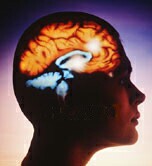
SATURDAY, Nov. 14 (HealthDay News) — Words and gestures are processed in the same areas of the brain, a finding that may improve understanding of the evolution of language, researchers say.
In the study, MRI was used to monitor the brain activity of 20 volunteers as they watched video clips of a person either acting out gestures or voicing phrases that matched the gestures’ meanings. Both the gestures and words triggered high levels of activity in the inferior frontal and posterior temporal areas, which are the language regions of the brain.
“If gesture and language were not processed by the same system, you’d have spoken language activating the inferior frontal and posterior temporal areas, and gestures activating other parts of the brain. But in fact we found virtual overlap,” study senior author Dr. Allen Braun, of the U.S. National Institute on Deafness and Other Communication Disorders, said in a news release.
The finding, published online in this week’s issue of the Proceedings of the National Academy of Sciences, suggests that these brain regions could be the evolutionary starting point for language.
“Our results fit a longstanding theory which says that the common ancestor of humans and apes communicated through meaningful gestures and, over time, the brain regions that processed gestures became adapted for using words,” Braun said. “If the theory is correct, our language areas may actually be the remnant of this ancient communication system, one that continues to process gesture as well as language in the human brain.”
In addition, learning more about how the brain processes gestures and words may help treat aphasia, a disorder that impairs a person’s ability to produce or understand language.
More information
The U.S. National Institute of Neurological Disorders and Stroke has more about aphasia.

